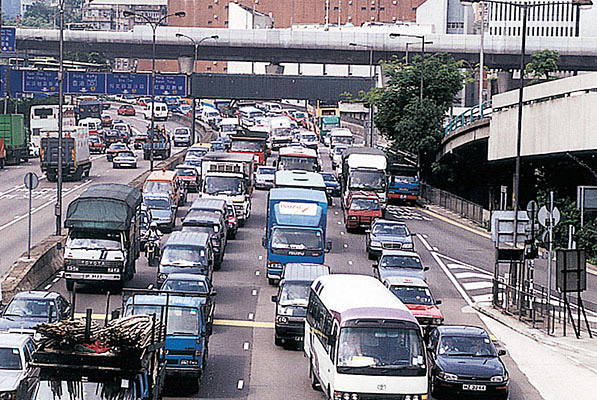 Annoying
Noise
Annoying
Noise
¡@
Noise disturbance is a common annoying problem in urban city. It is also the case in Hong Kong. With a high density of traffic fleet, commercial and industrial activities, Hong Kong people are living in a "high pressure bowl" and suffering from noise annoyance throughout a day. Traffic flow is a major source of noise in Hong Kong. Owing to close proximity to road networks, about one million people in Hong Kong are being exposed to excessive transport noise (EPD, 2000).


Traffic Noise as a major concern in Hong Kong, particularly acute along
the road systems built close to residential buildings
¡@
The most recent study, by the Planning, Environments and Land Bureau, reports that 655 out of 3,000 major roads have a peak hour noise level of exceeding the maximum acceptable limit L10(1 hour) 70 dB(A). It implies the nuisance to over 0.3 million households along the roads. According to the Third Comprehensive Transport Study, ten noisiest roads in Hong Kong are:
|
Road |
Noise Level (dB) |
No. of people affected |
|
Lung Cheung Road |
88.9 |
8,368 |
|
Kwai Chung Road |
86.3 |
5,600 |
|
San Tin Highway |
84.2 |
8,400 |
|
Tai Po Road |
84.1 |
6,800 |
|
Castle Peak Road |
83.4 |
6,300 |
|
Tuen Mun Road |
83.2 |
6,928 |
|
Chio Hung Road |
83.1 |
7,200 |
|
Tsing Yi |
82.4 |
10,800 |
|
Princess Margaret Road, Tsim Sha Tsui |
81.7 |
5,000 |
|
Cheung Pei Shan Road, Tsuen Wan |
81.3 |
8,836 |
One of the possible mitigation measures is to construct noise barrier on the roads with noise exceedence. It is now planned that 29 existing roads, such as Tuen Mun Road, Tai Po Road, and Tisng Yi Bridge, with excessive noise will be constructed with noise barrier, taking about 10 years to finish and costing over $23 billion.
 |
Cantilever style noise barrier at podium of Royal Ascot, Fo Tan |
¡@
But it is predicted that it can only help 70 % of about 24,000 households along these roads with the noise level dropping to below 70 dB(A). For a comfortable and peaceful living environment, such huge expense is necessary. But are such environmental costs avoidable? I think the answer should be YES, as long as Hong Kong has a better town planning. Now, the town planning in Hong Kong is road-oriented in order to ensure the city accessibility and public mobility. It turns out that the government usually puts priority to build road system first, and then develops the lands in between for either domestic, commercial or industrial land use. Consequently, road system cuts through the heart of the development area and closes to the public. Indeed, a better town planning should be human-oriented. To minimize adverse impacts on human health and quality environment, it is better to have the heart of development area being car-free or as few car as possible, with the major routes at the periphery zone instead. I believe that better town planning is critical to a quality environment, by preventing the happening of the potential environmental problems or at least minimizing the extent of the problems. it is believed that preventive approach of planning always costs less than the proactive approach, as some environmental damages cannot be compensated, like the case described above. Though the government takes the mitigation measures of building noise barrier, it is estimated that only 24,000 households can be benefited, and there are still 276,000 households suffering from excessive noise disturbance.
| Looking
Ahead
Highlighting the traffic noise problem in Hong Kong, the future initiatives suggested by the EPD include: (1) Design new highways to meet noise standard; (2) Review policy for redressing excessive traffic noise from existing roads and flyovers; (3) Improve the environment through urban redevelopment. |
¡@
